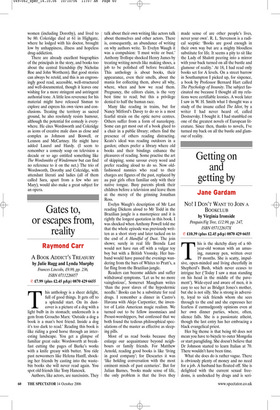The Gang of Three
Victoria Glendinning
THE FRIENDSHIP: WORDSWORTH AND COLERIDGE by Adam Sisman HarperPress, £20, pp. 480, ISBN 0007160526 ✆ £16 (plus £2.45 p&p) 0870 429 6655 Adam Sisman begins his story of one of the most famous friendships in literary history with the vivid account of a young man who, having already walked 40 miles, takes a short-cut across a Dorset cornfield, running to greet two people working in their garden. The young man is Samuel Taylor Coleridge and the friends are William Wordsworth and his sister Dorothy. Over the ensuing six years the three were rarely parted for long.
Their rambles together in the Quantocks are legendary. The two poets talked incessantly, declaiming their new poems, completing each other’s verses, planning a utopian community and a world ruled by reason, intoxicated by the ideals of the French Revolution — which was welcomed even by mainstream opinion in Britain, to start with, as extending to the continent those rights and liberties which the British have always fondly imagined that they themselves enjoy. Then, when radicals and dissenters began rattling the bars and demanding social changes which went further than the British establishment tolerated, there was a violent crackdown, like a ‘war on terror’. Wordsworth and Coleridge were spied upon in their rambles by security men who reported that they wrote things down in notebooks and talked in funny accents and that one of them cohabited with a woman who passed as his ‘sister’ — a common euphemism for mistress.
Actually, the relationship of Wordsworth with his sister Dorothy really was extraordinary. Necessarily, given the remit of this book, it is only a subplot. In a word, she adored him, and they behaved more like lovers than like siblings. She was hot-eyed, sensitive, passionate and uninhibited. When he went away for a few days she mourned over his discarded half-eaten apple. He managed to get married, to a plain, ‘sweet-tempered’ woman, whose sweet temper must have been as phenomenal as the suppressed hysteria of the two Wordsworths. At her brother’s insistence, Dorothy spent the night before the ceremony with the bride’s wedding-ring on her own finger. While the wedding took place, she lay in misery on her bed till the happy pair returned, when she ran downstairs ‘to greet my beloved William and fell upon his bosom’.
But the spotlight in this book is on the relationship between two great poets. Sisman remarks on the difficulty commentators have found in appreciating Wordsworth and Coleridge equally as human beings. On the face of it, there is no contest. Coleridge was spontaneous, impetuous, unpredictable, unkempt, eloquent and amusing. In the early years, he had published more than Wordsworth, and was well-known as a public speaker. Wordsworth, two years older, was a stiff, staid, frugal, costive sort of fellow. Sisman is even-handed, even when this involves stretching the apparent truth: he refers to Wordsworth’s disciplined mind, ‘fed on a rich hinterland of experience’, when he had never done a hand’s turn in his life and his only possibly rich experience was fathering a daughter in France, leaving the country before she was born. It is hard, too, from this account not to blame Wordsworth’s high-handed exclusion of much of Coleridge’s work from their seminal publication Lyrical Ballads for his own eventual dominance, and for Coleridge’s gradual loss of confidence and verve. Coleridge’s misery was compounded by his romantic passion for Wordsworth’s sister in-law. A believer in the indissolubility of marriage, Coleridge had an unpoetical wife who was much neglected, and ruthlessly excluded from the intimacies of ‘the gang’, as they called themselves.
It is quite surprising how the intense friendship between the two poets flowered so gloriously and for so long. Wordsworth mistrusted Coleridge’s metaphysical, supernatural streak, which was part of his genius. Coleridge disliked Wordsworth’s drive towards a poetry of plain speech and personal experience, which was part of his. They ‘pulled different ways’, as Words-worth put it. ‘An admirable Poet’, wrote Coleridge, ‘might be made by amalgamating him & me.’ But he called Wordsworth his ‘anchor’, and believed utterly in his greatness. The friendship was intense, emotional, selfconscious: ‘FRIEND is a very sacred appellation’, declared Coleridge, who needed someone to look up to. He had an idée fixe that Wordsworth must write the Great Poem which should encompass and make sense of all human knowledge and experience, and change the world — a heavy burden for Wordsworth, and a project never realised. The great friendship, too, ultimately failed, dribbling away in disappointment and bitterness. Both achieved fame in their lifetimes, but Wordsworth ended up in his native Lake District as a renowned sage, surrounded by adoring women (including Dorothy), and lived to be 80. Coleridge died at 61 in Highgate, where he lodged with his doctor, brought low by unhappiness, illness and hopeless drug-addiction.
There are already excellent biographies of the principals in the story, and books too about the central friendship (by Nicholas Roe and John Worthern). But good stories can always be retold, and this is an engrossingly good read, accessible, well-structured and well-documented, though it leaves one wishing for a more stringent and astringent authorial tone. A little less reverence for his material might have released Sisman to explore and express his own views and conclusions. Treating the territory as sacred ground, he also resolutely resists humour, although the potential for comedy is everywhere. He cites Wordsworth and Coleridge as icons of creative male duos as close and complex as Johnson and Boswell, or Lennon and McCartney. He might have added Laurel and Hardy. (I seem to remember a comedy soap on television a decade or so ago entitled something like The Wordsmiths of Windermere but can find no reference to it on the net.) The trio of Wordsworth, Dorothy and Coleridge, with attendant literati and ladies (all of them called Sara, apart from a few who are Mary), would also make a great subject for an opera.



































































































 Previous page
Previous page